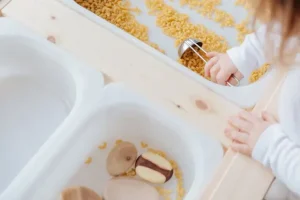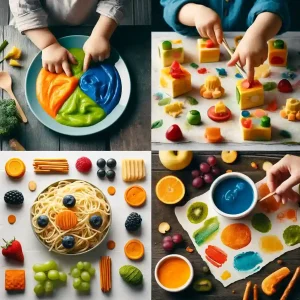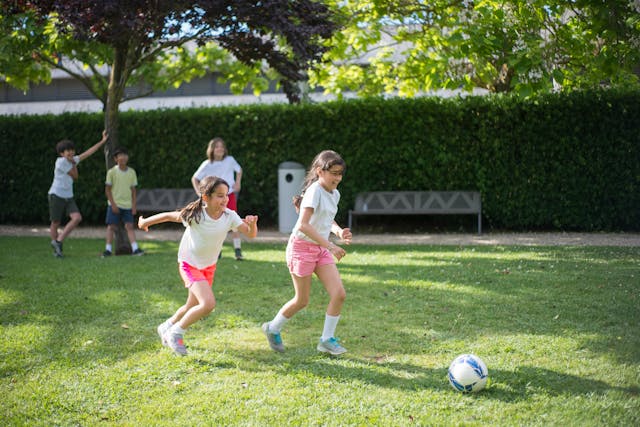Creative 20+ Sensory Food Play Ideas for your Child’s Development
If you’ve ever found yourself covered in spaghetti sauce because your little one decided it was finger paint, or if you’ve turned a blind eye to mashed potatoes being shaped into “mountains,” welcome to the wonderful world of sensory food play. As both a preschool teacher and a young mother, I’ve had my fair share of messy adventures, and let me tell you, it’s all part of the fun and learning process. So, let’s dive into why these food escapades are more than just chaos—they’re crucial for your child’s development.

Extensive Sensory Food Play Ideas
To keep things exciting, here’s a list of 30 creative and engaging food play activities:
- Finger Painting with Food:
- Use pureed vegetables and fruits to create colourful art on a plate or paper. This activity enhances creativity and introduces children to new textures and colours.
- Teddy Bear Picnics:
- Host a pretend picnic with stuffed animals and a variety of snacks. It’s a fun way to encourage imaginative play and social interaction.
- Making Food Jewelry:
- Use string and items like Cheerios, pasta, and berries to create edible jewellery. This helps develop fine motor skills and creativity.
- Food Sculptures:
- Provide foods like cheese cubes, grapes, and pretzel sticks to build structures. This activity boosts creativity and fine motor skills.
- Texture Exploration:
- Introduce different textures by providing foods like cooked spaghetti, mashed potatoes, and gelatin. Encourage your child to describe how each feels, enhancing sensory vocabulary.
- Fruit and Veggie Stamps:
- Cut fruits and veggies into shapes and use them as stamps with food colouring. This combines art and sensory play, enhancing creativity and motor skills.
- Edible Playdough:
- Make playdough from edible ingredients like peanut butter, powdered milk, and honey. It’s safe for kids who might taste their creations.
- Food Sorting:
- Sort different types of beans, pasta, or cereals by size, shape, or colour. This activity aids in developing sorting and categorising skills.
- Sensory Bins:
- Create sensory bins with items like rice, beans, or oatmeal for digging and pouring. Sensory bins stimulate tactile exploration and fine motor skills.
- Pasta Necklaces:
- Dye pasta with food colouring and thread it onto string to make necklaces. It’s a fun way to develop fine motor skills and colour recognition.
- Cereal Box Collages:
- Use empty cereal boxes to cut out shapes and create collages. This activity encourages creativity and recycling.
- Vegetable Cars:
- Assemble cars using cucumber slices, cherry tomatoes, and toothpicks. It’s a playful way to introduce children to vegetables.
- Fruit Faces:
- Make funny faces on plates using slices of fruit and vegetables. This activity encourages healthy eating and creativity.
- Rice Play:
- Dye rice with food colouring and use it for sensory play. It’s great for tactile exploration and fine motor skills.
- Bubble Wrap Stomp:
- Spread bubble wrap on the floor, cover it with paint and let children stomp on it. This combines sensory input with gross motor activity.
- Cooking Together:
- Involve children in cooking simple recipes, allowing them to mix and measure ingredients. This fosters practical skills and a positive relationship with food.
- Jelly Play:
- Set jelly in different containers and let children squish and explore it. Jelly play is great for tactile exploration and sensory fun.
- Fruit and Veggie Kabobs:
- Let children make their own kabobs with a variety of fruits and veggies. It’s a fun and healthy way to explore different foods.
- Spaghetti Sensory Play:
- Cook spaghetti and let children play with it in a bin, adding food colouring for more fun. It’s great for tactile exploration and imaginative play.
- Flour and Water Mixtures:
- Mix flour and water to create different textures for sensory play. This activity is simple yet highly engaging.
- Ice Cube Painting:
- Freeze coloured water in ice cube trays and let children paint with the melting cubes. It’s a cool way to explore colours and textures.
- Fruit Salad Creation:
- Allow children to chop and mix their own fruit salads. It’s a healthy and fun way to engage with food.
- Herb Exploration:
- Introduce fresh herbs for smelling, touching, and even tasting. This activity enhances sensory experiences and knowledge about herbs.
- Edible Sensory Paths:
- Create paths with different textured foods for children to walk on. This combines sensory play with gross motor skills.
- Bubble Blowing with Straws:
- Blow bubbles in a tray of milk using straws. It’s a fun way to explore bubbles and textures.
- Food Puzzles:
- Cut fruits and vegetables into puzzle pieces and let children reassemble them. This activity enhances problem-solving skills and fine motor coordination.
- Bean Bag Toss:
- Make bean bags filled with different types of beans for tossing games. It’s great for sensory exploration and gross motor skills.
- Veggie Painting:
- Use broccoli, celery, and other veggies as brushes for painting. This activity combines art and sensory play.
- Mashed Potato Play:
- Provide mashed potatoes for squishing and moulding. It’s a fun way to explore textures and engage in creative play.
- Popcorn Play:
- Use popped popcorn for sensory bins or craft activities. It’s great for tactile exploration and creative projects.

Practical Setup Tips for Sensory Food Play Ideas
Setting up for sensory food play doesn’t require a professional kitchen or expensive materials. Here are some practical tips to get started:
Create a Non-Pressure Environment:
Separate playtime from mealtime to remove the pressure of eating. This way, children can explore food without the expectation to consume it.
Materials and Safety:
- Materials: Use a variety of safe, edible materials such as cooked pasta, rice, and soft fruits. Non-food items like spoons, cups, and cookie cutters can add to the fun.
- Safety: Always supervise to prevent choking hazards and ensure all food used is age-appropriate.
Step-by-Step Guidance:
- Prepare the Area: Lay down a plastic sheet or newspaper to catch any spills.
- Gather Supplies: Have a variety of foods and tools ready.
- Encourage Exploration: Let your child touch, smell, and play with the food without any restrictions.
Perspectives as a Preschool Teacher and a Young Mother
In my classroom, sensory food play is a daily activity. I’ve seen how children light up when they’re allowed to explore food beyond just eating it. The classroom becomes a vibrant lab of textures, smells, and colours, from building towers with carrot sticks to squishing peas between their fingers. These activities aren’t just about making a mess (though that’s a fun part!); they’re about learning and discovery. Children develop fine motor skills, enhance their creativity, and learn to interact with food in a positive, pressure-free environment.
At home, sensory food play takes on a different flavour. With my little one, every meal is an opportunity to explore. Yes, it means extra cleaning, but the joy and developmental benefits make it worthwhile. I’ve found that engaging in sensory food play at home can be as simple as letting my child help with meal prep—mixing, mashing, and even taste-testing. These activities not only make mealtime more enjoyable but also help in easing food anxieties and picky eating habits.
Addressing Sensory Issues and Picky Eaters
Sensory food play can be a game-changer for picky eaters and children with sensory issues. Here’s how:
Encouraging Participation:
- Gentle Introduction: Start with familiar foods and gradually introduce new textures.
- Positive Reinforcement: Praise your child for exploring, even if they don’t eat the food.
Techniques to Reduce Anxiety:
- Desensitisation: Gradually increase the exposure to different foods in a non-threatening way.
- Modelling: Show your child how to play with food by joining in the activities.
Success Stories:
- A child who refused vegetables began to enjoy them after using them in food painting activities.
- A picky eater started trying new foods after participating in teddy bear picnics regularly.
Emphasis on Patience and Fun
Creating a non-pressure environment is key. Here’s how to maintain a positive and patient approach:
Encouraging Fun and Exploration:
- Focus on Play: Emphasize the fun aspect rather than the eating part.
- Celebrate Small Wins: Any positive interaction with food, no matter how small, is a step forward.
Maintaining a Positive Approach:
- Patience: Understand that progress can be slow, and that’s okay.
- Joyful Environment: Keep the mood light and fun to encourage exploration.
Overcoming Challenges Related to Sensory Play with Food
Despite the benefits, sensory food play can present challenges. Here’s how to tackle them:
Common Concerns:
- Messiness: Embrace the mess! Lay down protective coverings and dress your child in old clothes.
- Picky Eaters: Use sensory play to gradually introduce new foods without pressure.
Tips for Dealing with Picky Eaters and Food Allergies:
Allergy-Safe Foods: Always check for potential allergens and opt for safe alternatives. Introduce new foods slowly and in a fun way.
Gradual Introduction: Introduce new foods slowly and in a fun way, allowing children to explore them without pressure.
Lead by Example: Join in the play to show it’s safe and fun. Children are more likely to participate when they see their parents involved.
Positive Reinforcement: Praise and encourage any interaction with food, even if it’s just touching or smelling it.
Conclusion
Sensory food play is more than just messy fun; it’s a valuable tool for development, particularly for picky eaters and children with sensory issues. By creating a positive, pressure-free environment, we can help our children explore and enjoy food in new ways. So, roll up your sleeves, embrace the mess, and watch your child’s world of food exploration come alive!
From both a preschool teacher’s and a young mother’s perspective, the long-term benefits of sensory food play are undeniable. Let’s make every meal an adventure and every bite a step towards a positive relationship with food. Happy playing and happy eating!









